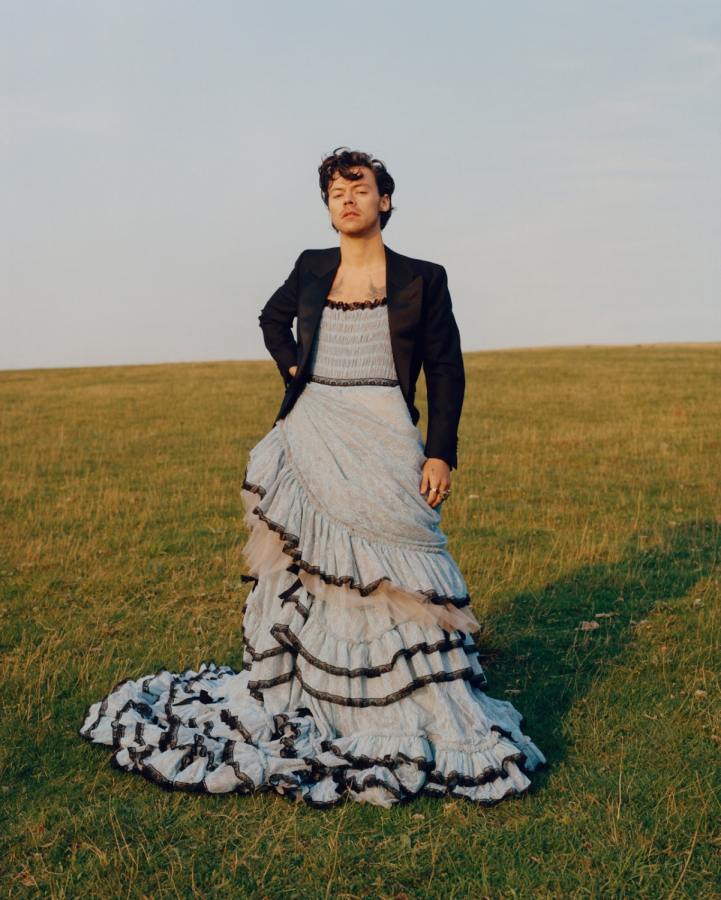Breaking Gender Barriers in Fashion
December 13, 2020
On November 13, 2020, Vogue released its newest issue featuring solo artist Harry Styles wearing a dress on the cover. While most fell in love with the photos that were released inside the magazine of him appearing very feminine, some spoke out against it. Politician Candance Owens talked about how men wearing dresses was not “normal,” asking to, “bring back manly men.” Candance, perhaps inadvertently, prompted a necessary conversation: What makes a man “manly?”
Clothing is a form of expression. The clothes one wears, their style, is a form of representation. We show our interests and likings through clothing, for example, when we wear our favorite artists’ merchandise. Clothing is supposed to make us feel confident and comfortable and does not need to represent our gender. Clothing has no gender, but society has created this belief that women are supposed to wear dresses and men are supposed to wear suits. This has also applied to makeup. Instead of makeup being an art form anyone can use to convey their creativity, it’s been tied to only women. Some think of this as a way to show order and separate genders, but that mindset is only a restriction.
Looking back in history, trousers were originally made for warriors. During this era only men were allowed to wear such clothing because it was easier to hunt and fight in, according to the British newspaper, The Independent. Trousers, consequently, became a sign of strength made only for men and dresses were made only for women. There have been people who have tried to break these stigmas that surround clothing in order to create new social norms by wearing whatever they wanted, no matter what gender it “belonged to.” These people started a movement in the fashion industry, and pop-culture icons such as David Bowie, Prince, Annie Lennox, Patty Smith, and Boy George, played a pivotal role in pioneering this gender-bending fashion. They were among the many artists that did not hold onto the rigid ideas of what men or women were “supposed” to look like. Many of their fans loved their look and felt liberated by it. It sparked an evolution of fashion that was very androgynous. Gender-fluid styles continue to be popular and celebrities like Harry Styles, Jayden Smith, Lady Gaga, Miley Cyrus, Timothée Chalamet, and Billy Porter are still breaking down barriers. This has inspired many different audiences, to the point that the lines that separate genders in clothing have become blurred. However, along with the love and support these artists received, there has also been backlash.
Like Candace Owens, many think these gender barriers exist for good reason. They follow the stereotypes that are tagged to genders such as the notion that men are strong and women are gentle. They believe that men need to be “manly” and in order to do so they must dress as a man “should.” But how does clothing have anything to do with what it is to be a man? The answer is it doesn’t. This toxic pattern of thinking has made people believe that it does.
Hypermasculinity amplifies stereotypes in men. It pushes the idea that physical strength, aggression, and sexuality defines what a man is. This has been engraved into society’s mind and has resulted in vulnerability being seen as weakness. The problem is that vulnerability has become something that’s associated with women instead of something normal that exists in all of us. Throughout history, women have been seen as fragile objects that need to be protected by a man, so a man wearing what is considered women’s clothing is seen as wrong because of our society’s internalized misogyny. Misogyny is prejudice against women, and it pervades our communities without many of us even realizing it exists. It’s a thought process that needs to be undone because it traps people into a world of fear from judgement.
It’s important to note that men dressing femininely doesn’t mean others can’t dress masculinely and the same goes for women. Being open and more accepting of what people choose to wear creates a world where more people are included and heard.
Clothing does not define our strength. It simply helps to express who we are as people, and regardless of how we do that, we as a society need to see each other as unique and beautiful.






























